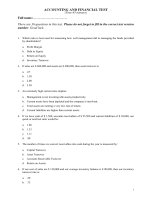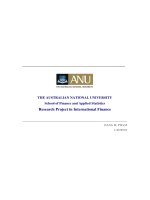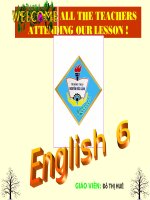- Trang chủ >>
- THPT Quốc Gia >>
- Hóa
Fossils and dinosaurs
Bạn đang xem bản rút gọn của tài liệu. Xem và tải ngay bản đầy đủ của tài liệu tại đây (2.13 MB, 12 trang )
Earth Sciences
Standards
Preview
Standard Set 3. Earth Sciences
3. Earth is made of materials that
have distinct properties and provide
resources for human activities. As the
basis for understanding this concept:
3.d. Students know that fossils provide
evidence about the plants and animals
that lived long ago and that scientists
learn about the past history of Earth
by studying fossils.
by Peggy Bresnick Kendler
Genre
Nonfiction
Comprehension Skill
Use Graphic
Organizers
Text Features
•
•
•
•
Captions
Diagrams
Labels
Glossary
Science Content
Fossils and
Dinosaurs
Scott Foresman Science 2.7
ISBN 0-328-23513-X
ì<(sk$m)=cdfbdb< +^-Ä-U-Ä-U
Vocabulary
dinosaur
fossil
skeleton
Fossils
and Dinosaurs
Picture Credits
Every effort has been made to secure permission and provide appropriate credit for photographic material. The
publisher deeply regrets any omission and pledges to correct errors called to its attention in subsequent editions.
Unless otherwise acknowledged, all photographs are the copyright of Dorling Kindersley, a division of Pearson.
ISBN: 0-328-23513-X
Copyright © Pearson Education, Inc. All Rights Reserved. Printed in the United States of America.
This publication is protected by Copyright, and permission should be obtained from the publisher prior to any
prohibited reproduction, storage in a retrieval system, or transmission in any form by any means, electronic,
mechanical, photocopying, recording, or likewise. For information regarding permission(s), write to
Permissions Department, Scott Foresman, 1900 East Lake Avenue, Glenview, Illinois 60025.
1 2 3 4 5 6 7 8 9 10 V010 13 12 11 10 09 08 07 06
by Peggy Bresnick Kendler
What is a fossil?
A fossil is a print or part of a plant or
animal that lived long ago.
Some old bones are fossils.
Shapes left in rocks can also be fossils.
Scientists study fossils.
They study them to learn about living
things from long ago.
This scientist is
digging up fossils.
This is a fish fossil.
2
3
What Fossils Show
Some fossils are of living things that no
longer live on Earth.
Fossils show the size and shape those
living things had.
Look how the lizard fossil formed.
The lizard died.
It got covered in mud and sand.
The sand and mud turned to rock.
The pictures show how
some fossils are formed.
A Fossil Is Formed
4
5
How do we learn
about life long
ago?
Scientists pick up clues about the past
from fossils.
This helps them learn about life on Earth
long ago.
Scientists can find fossils that are old
dinosaur bones.
They can build skeletons from the fossils.
A skeleton is all the bones of a body.
This is the skeleton
of an animal called
a dinosaur.
This scientist is
trying to build
a dinosaur
skeleton.
6
7
Dinosaurs on Earth
Dinosaurs were animals that lived on
Earth long ago.
Their fossils can show how they lived
and what they looked like.
Fossils can show how Earth has
changed.
The picture shows how Earth might have
been when dinosaurs lived.
Earth might have
looked like this.
8
9
New Discoveries
Scientists found a tyrannosauroid
skeleton in China.
This dinosaur ate meat.
It was about 2 meters long.
Its feathers kept it warm.
But it could not fly.
Scientists rebuilt the tyrannosauroid.
Look at the picture.
It shows what the dinosaur might have
looked like.
This is a drawing of a
tyrannosauroid.
Tyrannosauroid skull
10
11
What were
dinosaurs like?
Many kinds of dinosaurs lived on Earth.
No dinosaurs live on Earth today.
Scientists learn from dinosaur fossils.
These fossils show things about dinosaurs.
Some dinosaurs were very big.
Others were small.
Gallimimus
Compsognathus
12
13
Dinosaur Food
Scientists study what dinosaurs ate.
Some dinosaurs had long, sharp teeth.
They ate animal meat.
Other dinosaurs had short, flat teeth.
These dinosaurs ate plants.
Here you see a Triceratops skull.
Triceratops had flat teeth and ate plants.
The three horns on its head may have
protected it.
Tyrannosaurus rex
ate meat.
Triceratops ate plants.
14
15
How are plants
and animals of
long ago like
those today?
Footprints help us learn about animals.
An Iguanodon footprint shows that this
dinosaur probably walked on its toes.
See the bear footprints? Bears walk with
their feet and toes flat on the ground.
Iguanodon footprints
Some birds from long ago had feathers
and beaks.
Birds today have these things.
Some birds from long ago had sharp
teeth and long, bony tails.
Now most birds do not have these
things.
Archaeopteryx
fossil
Bear footprints
Canada goose
16
17
Plants Long Ago and Today
Plant fossils show the size of plants from
the past.
They show the shape of these plants too.
Scientists study plant fossils.
They learn how plants from long ago
are like plants today.
Ferns lived long ago and still live today.
Living ferns look like fossil ferns.
Plant fossils are sometimes black.
Today’s plants are green.
Plants from long ago were also
probably green.
A fern fossil
This kind of fern
lives today.
18
19
What did you learn?
Glossary
1. Why might a Triceratops have had horns?
dinosaur
fossil
skeleton
20
animal that lived on Earth long ago
a print or part of a plant or
animal that lived long ago
2. How are birds from the past and today’s birds
different?
3.
Write about a time you
saw a fossil in a museum or in a book. Use
details to describe what the fossil was like.
4.
Use Graphic Organizers Tell how fossils
are formed. Use a graphic organizer to show
what happens.
all of the bones of a body









